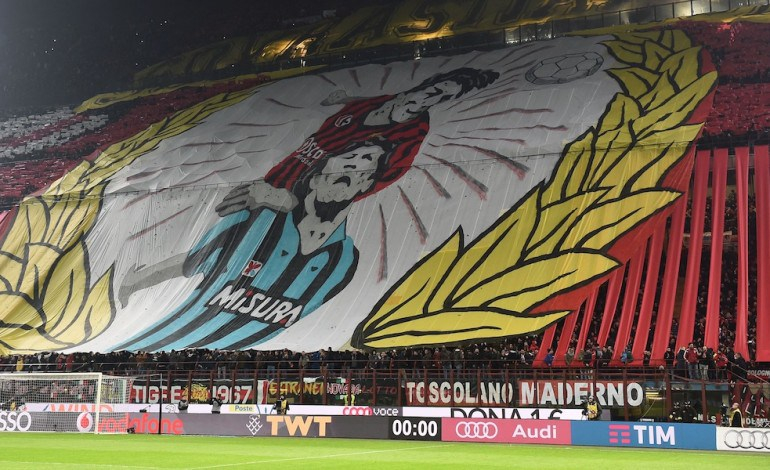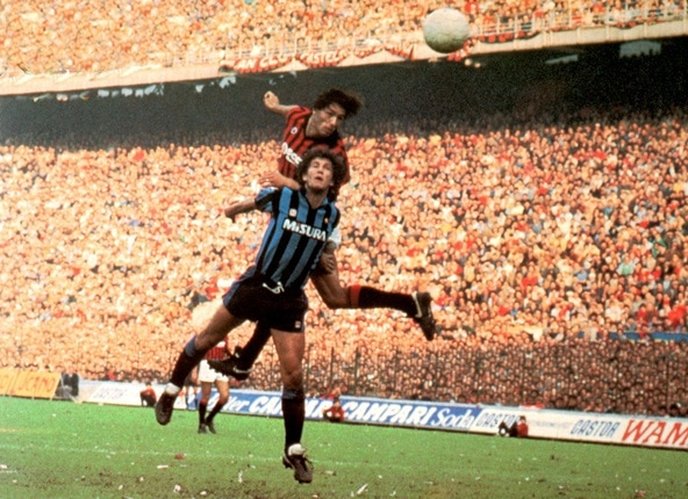Italian football can be an unforgiving world for British footballers. Its methodical practice, tactical rigours and conformist culture has alienated and unhinged some of Britain’s finest exports.
Jimmy Greaves, Dennis Law, Joe Baker, and Ian Rush all struggled to adapt to the hard-line approaches of the peninsula’s coaches, and the panopticon surveillance of its unrelenting media. Few Brits can truly claim to have been an unmitigated success in Italy. John Charles’ prolific tenure at Juventus between 1957 and 1962 – winning three Scudetti and scoring 93 goals in 150 games – remains an exception.
Others have enjoyed cult status without truly delivering on the pitch. Paul Gascoigne is an example par excellence. Despite his career-stymieing injuries and psychological battles, his gregarious, mischievous and down-to-earth persona ensured he was idolised amongst fans of S.S. Lazio. That and the small matter of his late equaliser in the Rome Derby of 1992. Indeed, making a name for yourself in the derby can be a sure-fire way to lighting the touch paper with Italian fans. For Mark Hateley, this certainly proved the case at AC Milan.
In the summer of 1984, two of football’s most distinguished names earned record breaking moves to Serie A. Diego Maradona left Barcelona to join Napoli for £6.9 million (then a world record fee) and Internazionale paid £4.7 million for Bayern Munich’s Karl-Heinz Rummenigge. Accompanying the duo, and joining the likes of Zico (Udinese), Socrates (Fiorentina) and Michel Platini (Juventus) in Serie A’s star-studded cast, was Portsmouth’s Mark Hateley.
AC Milan paid the second division outfit £1 million for the then 23-year-old English forward. Hateley was bought to replace his compatriot Luther Blissett, who, over the course of one dismal year, had dumbfounded the Rossoneri faithful to the extent that he had earned cult status for being a super-bidone (rubbish in Italian football parlance). Though Hateley had enjoyed a prolific season on the South Coast, scoring 22 goals in 38 games, the reality of AC Milan plundering England’s second tier for attacking talent put their travails into stark contrast.
At the time, the club were recovering from one of the darkest periods in their history. In 1980, the Rossoneri had been relegated to Serie B due to their involvement in the Totonero betting scandal – just one year after winning their tenth Serie A title. Two years later, having bounced straight back to Serie A, Milan were relegated once again – this time due to desperately poor performances on the field.
Matters were accentuated by the comparative success of their city rivals, Inter, who had been crowned Serie A champions during Milan’s first relegation, and Coppa Italia champions during their second. Inter’s supremacy was most conspicuous in the Milan Derby, having enjoyed a six-year unbeaten run between 1979 and 1984. Throughout these years, Milanisti suffered whilst their rivals revelled in schadenfreude. That was until Hateley stemmed the tide of blue and black dominance, etching his name into Milan folklore.
The former Portsmouth man was not the only English player who moved to Italy’s fashion capital in the summer of 1984. Manchester United midfielder, Ray Wilkins, had also joined AC Milan and the two helped each other settle, albeit at the expense of their Italian language skills. Benefiting from his compatriot’s company, Hateley’s impact was instant. In the run-up to the season’s first Derby della Madonnina, the languid forward struck four times as Milan went unbeaten in their opening six games. The Italian press and Hateley’s teammates were suitably impressed. “He [Hateley] really surprised me,” remarked Milan’s captain Franco Baresi. And with the Milan Derby approaching, the scene was set for the Englishman’s finest hour in red and black stripes.
Six years without a win against your fiercest rivals is an eternity in footballing terms. On 28 October 1984, the Rossoneri were not favourites to change this statistic. They were facing a formidable Inter side, led by a number of influential figures including; Walter Zenga in goal, World Cup winning defenders Beppe Bergomi and Fulvio Collovati, Irish midfielder Liam Brady and Alessandro Altobelli and Rumenigge up front. Despite Milan’s promising start to the season, they were a side in transition, most notable for the burgeoning brilliance of Baresi.
For Hateley and Wilkins, the tumult that greeted them as they emerged from the San Siro’s tunnel left them under no illusions regarding the grandeur of this fixture. Appearing on Channel Four’s ‘Football Italia’ show years later, Wilkins described the feverish atmosphere: “Blue and black at one end, red and black at the other, the smoke meeting in the middle, it was something quite fantastic.” His side, however, were initially overawed as Inter took an early lead through Altobelli’s diving header. After withstanding further Nerazzurri pressure, some intricate build-up play between Hateley, Wilkins and Pietro Paolo Virdis set-up Agostino Di Bartolomei, who volleyed Milan level from close range.
Then, with 25-minutes remaining, Hateley’s moment arrived. Baresi made a characteristically well-timed tackle to rob Altobelli of possession deep inside Inter’s half. As the ball broke to Virdis on Milan’s left, he took a couple of touches to compose himself and curled a cross towards his strike partner. Hateley, who was floating around the penalty spot, towered above Collovati – a defender renowned for his aerial ability – and crashed a header past the flailing dive of Zenga. 2-1, and that is how it finished.
Hateley’s iconic leap over Collovati for his ‘epoch-making’ goal
Praise was heaped on the performances of both Milan’s Englishmen. The most flamboyant tribute was voiced by the Italian director and screenwriter, Ugo Tognazzi, who defined Wilkins and Hateley as “two rare and refined English species in a divine dish.” But it was the latter’s goal that entered into the realms of myth.
For more than 80-years, the team who had taken the lead in the Derby della Madonnina had, at the very least, secured a draw. Hateley’s leap had delivered the Rossoneri divine intervention. Inter fan, Tommaso Pellizzari, called it an “epoch-making goal”, one that broke Inter’s hegemony in the city. Meanwhile, on a fanzine, a Milan fan wrote “for years I had a gigantic poster of Hateley’s goal by my bed: for us, that game meant a return to winning ways after years of purgatory.”
The defeat did not sit well with Inter’s president, Ernesto Pellegrini. In the aftermath, he bumped into his opposite number Giuseppe Farina and allegedly told him, “congratulations, you won the battle, but the war will be ours.” Inter finished third, two places above their city rivals. But the ultimate prize eluded them and they were helpless to stop the inexorable rise of Osvaldo Bagnoli’s Verona, who won a miraculous first Scudetto title.
The image of Hateley climbing above Collovati was also one for the ages. “I was in awe,” said Mauro Tassotti after the game, “Hateley’s leap was incredible, demonstrating his timing and strength.” The former Milan defender was stood just yards away from the goal and he drew parallels between Hateley and Italy’s last great British success, John Charles. “It was the quintessential English forward’s goal, just like John Charles. And against an uncompromising defender like Collovati, […] it was a moment of incredible athleticism.”
Charles’ himself added to the hyperbole by claiming: “Mark’s fame will surpass my own. Italian defenders are good, but against British forwards like Hateley, their tactical astuteness is not enough.” The goal had indeed embodied the Englishman’s finest attributes: his power, combative nature and clinical finishing. His dishevelled appearance and long hair fit the ‘warrior’ blueprint and the Milan faithful promptly nicknamed him ‘Attila’, after the fearsome leader of the Hunnic Empire.
The Gazzetta dello Sport milked this dynamic, publishing photos of the goal under headlines such as “Mark Attila has struck again.” According to John Foot, one Gazzetta reporter wrote:
“He is like Conan, the mythical, invincible barbarian. Like a barbarian, Hateley looks his opponents in the eye, like a barbarian he throws himself into the most furious of battles and like a barbarian, he celebrates when his rivals are destroyed.”
As a matter of fact, physical prowess was not the only weapon in Hateley’s armoury. He was an intelligent operator, one constantly aware of his surroundings and his opponent’s flaws. “Top strikers try to identify the weakest link in a defence,” Hateley later told Scottish journalists during his time at Rangers. It was this shrewd and ruthless streak that made him an especially troublesome opponent for defenders.
But in Italy, Hateley will forever be remembered for his derby day heroics. Despite auspicious beginnings, he was curtailed by injuries throughout his three year stay in Milan. He went on to score 17 goals in 66 games and his fitness problems irked Milan’s president, Giuseppe Farina. In 1987, the arrival of Silvio Berlusconi as president heralded the dawn of a glorious era for the Rossoneri. With the club heading in a new direction, the media magnate desired grace over graft. Marco Van Basten was Berlusconi’s man and Hateley was on his way to Monaco.
Nevertheless, Hateley retains fond memories of his time in Milan, especially his derby day heroics. “I keep two huge photos of that goal on my wall at home, one in black and white and one in colour,” the Englishman later told Milan Channel, “it was one of the most beautiful and important goals of my life, a joyous moment for all of us and especially for the fans after a number of difficult years.”
And just like Hateley, these fans still remember the goal as if it were yesterday. So much so that, during the Derby della Madonnina in January earlier this year, Milan fans unveiled a majestic choreography celebrating the famous strike. The display, depicting the Englishman leaping above Collovati, engulfed the entirety of the San Siro’s Curva Sud and was accompanied by a banner read ‘sovrastiamoli’ - ‘we tower above them’. The tribute had an almost prophetic effect as the Rossoneri triumphed 3-0, set on their way thanks to a powerful header by the Brazilian centre-back Alex.
Hateley, who was covering the game on television as a pundit for beIN Sports, was understandably moved: “When I saw my face represented in the choreography I was shocked,” he told Milan Channel, “my colleagues were discussing the game while I remained stupefied, lost in that image. It’s incredible to think that after 30-years the fans still remember that goal. I can only thank the Curva Sud and those who came up with the idea.”
On Sunday evening, the San Siro will take centre stage once again for the season’s first Derby della Madonnina. Inter might count themselves fortunate. For unlike the derby of October 1984, AC Milan’s frontline won’t be led by their very own Mark ‘Attila’ Hateley.


